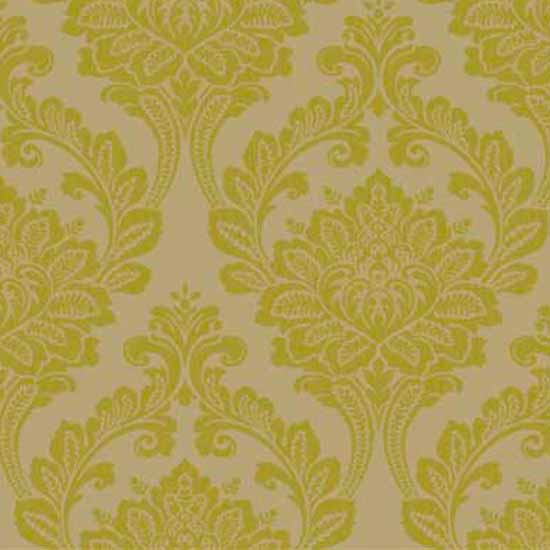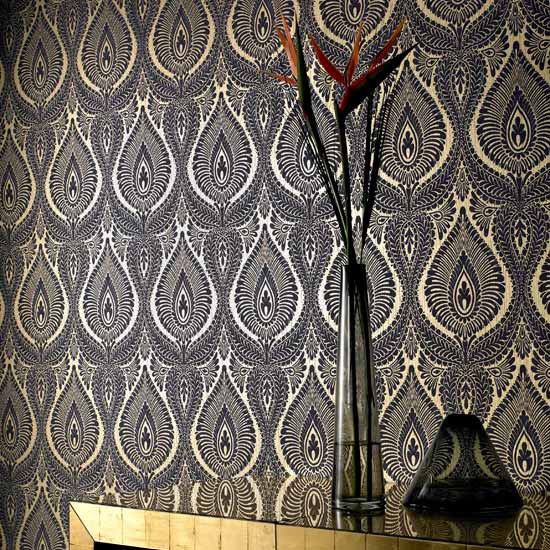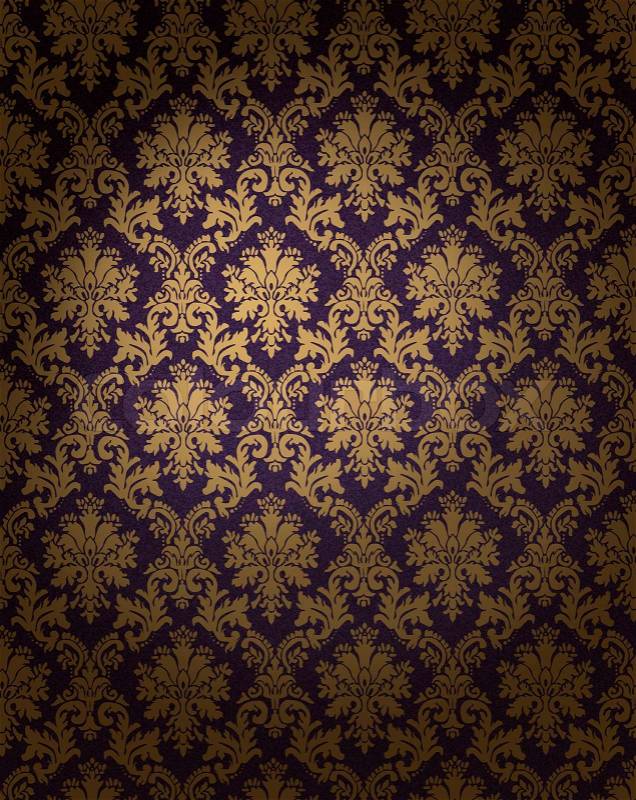Damask Wallpaper Biography
Source(google.com.pk)Damask, once restricted to formal rooms, has today come into much more general use than ever before in its long history. In this adaptation to our 20th century life, two extremes of patterns have evolved. One is characterized by new colour effects, the other simulates a fabric dulled and worn by age. And under good decorators or discriminating householders, damask-covered furni- ture and window and other draperies are successfully associated with fine furnishings of many periods, including our own.
The damask weave is a fabric on which the pattern is brought out by the lines of its weave running in a different direction from that of the ground. Damask linen tablecloths illustrate this beautifully. In modern damask, there are incor- porated with the traditional silk other materials, such as cotton, linen, wool and artificial silk, in order to produce new effects. The fabric is, however, made in essentially the same manner as in the 12th century, when it got its present name from the city of Damascus, then famous for the beauty of its silks of this character.
Most of the designs used in damasks today are copies of those woven centuries ago in Italy, Spain and France. This varied background allows the damask-covered chair, couch or window draperies to fit into the prevalent vogue for Spanish, Italian, French or Georgian interiors. Though damask weaving was not an English art, the English decorators of the 18th century used large quantities of Italian damasks, both for furniture coverings and as hangings for walls.
In France, the period of Louis XVI – a period of dignified luxury – developed many beautiful symmetrical designs, often with stripe effects combined with flowers and leaves. Most of the Italian weaves now reproduced hark back to Renaissance motifs, wherein the pomegranate, the apple of love of medieval times, surrounded by flowers and leaves, often forms part of the pattern. Tones of colour are found in some of these old Italian fabrics – violet and crimson, or an old gold that has the Cinquecento charm.
While the best designs of damasks are derived from precious bits preserved in museums, there are also patterns inspired by the life of today. Some designs sug- gestive of Japan are in brilliant reds, like those employed in lacquer; the straight trunks of the bamboo are shown against misty mountains and violet clouds. Especially modernistic is a pattern of new flower forms that may have been inspired by roses, but it is removed from reality by diagonal rays of darker tones that slant across the pattern. Delicate peach, jade or other hues, never used by the old Italian and French damask weavers, make these modern weaves distinctive.
Damask wallpaper is synonymous with luxury and sophisticated style. With a rich history as a cultured and fashionable design element, todays damasks draw on regal Victorian fabrics. These damask wallpapers bring a timeless beauty to walls, with realizations of the damask ranging from traditional to glamorous. Recognized globally as a compelling form, the damask is at home in any decor style from opulent and lavish to sleek and modern. Damask wallpaper can be used can be used to adorn
I have drawn largely to working on a damask-inspired design during this project, and it was suggested that I research the history of damask to more fully understand my relationship to it in contemporary terms.
During this research, I discovered an article written by Shax Riegler who has studied in New York at the Bard Graduate Centre for Studies in Decorative Arts and worked as editor/writer at Martha Stewart Living, Travel & Leisure, Vogue and House & Garden.
He summarises quite succinctly similar information I have come across on the web and I have included his article, “The Sumptuous World of Damask” in this post. Click here to visit his site for more information.
The Sumptuous World of Damask
by Shax Riegler for Martha Stewart Living, January 2006
A Chinese writer once likened the reverse side of a woven fabric to a language that has been translated: The threads are there, but the complexity of colors and shapes is lost. While this may be true of most textiles, damask is a dazzling exception. It is woven in such a way that the pattern on one side is the inverse of the other. The double-faced design lends itself to a variety of applications. And because the fabric is often made with fine materials and comes in elaborate motifs, it is one of the world’s most luxurious and intriguing fabrics. “I’m drawn to the patterns, the weave, and the extraordinary colors,” says Martha, who collects nineteenth-century French and Italian damasks, and whose home in Seal Harbor, Maine, was the setting for this story.
Traditionally, damask is monochromatic, made from a single shade of silk or linen. The pattern is distinguished by the way light plays off the warp, or vertical, and weft, or horizontal, threads. Some damasks even look different depending on the time of day. Over the last century, the definition of damask has expanded to include fabrics made with two or three colors, as well as other fibers, such as cotton, wool, or rayon. Still other fabrics are merely printed to look like damask, but these, of course, are not reversible.
The first silk damasks, consisting primarily of botanical and animal patterns, were produced in China around 300 B.C. They were traded along the Silk Road, which stretched from the Far East to the Mediterranean, and may have gotten their name from Damascus, one of the cities merchant caravans passed through en route to Europe. This was the beginning of a fascinating history. Damask and fabrics like it were so coveted that rulers of kingdoms went to great lengths to learn the secrets of silk weaving. In the sixth century, the Byzantine emperor commissioned monks to smuggle silkworms out of China in hollowed-out walking sticks. During the Second Crusade, weavers were taken from Greece and installed in royal workshops in Palermo, Sicily. Their methods spread to Venice, Lucca, and Genoa, where versions of Chinese and Arabic motifs were produced starting in the fifteenth century. By the 1700s, weavers in Lyon, France, were putting a more naturalistic spin on already-popular Asian and European designs. Aristocrats entertained in rooms appointed with matching damasks on walls, curtains, and upholstered furniture. Napoleon favored overscale neoclassical imagery such as urns, eagles, and shields, as well as — naturally — N motifs. The Industrial Revolution ushered in mass production, making woven and printed fabrics more affordable for the growing middle class. Later, during the Arts & Crafts movement — whose proponents saw machine-made designs as inferior and immoral — damasks were once again hand-crafted, often depicting stylized images of plant and animal life.
Damask table linens have their own story. They were first produced in the 1600s, when weavers in the Low Countries (today’s Belgium and the Netherlands) began making fine-quality white linen damask tablecloths and napkins. These were embellished with the previously established patterns, as well as intricate scenes including depictions of famous battles or stories from the Bible. Linen damask became de rigueur on the tables of well-to-do Europeans and Americans — a trend that continued for centuries. In 1926, etiquette expert Emily Post wrote of damask, “No other table covering, no matter how fine or elaborate, satisfies our inherent sense of faultless suitability.” Today’s tastemakers still agree with her.
Despite its historic roots, damask can appear delightfully up-to-date. “It looks equally good in simple, contemporary interiors as is does in more lavish, traditional abodes,” Martha says. Case in point: At Fallingwater, architect Frank Lloyd Wright’s 1937 masterpiece of modern domestic design near Pittsburgh, a gold damask bedspread shimmers in the otherwise spare wood-and-glass master bedroom. On these pages, you’ll find ideas for incorporating damasks into your home. All are beautiful, glamorous, and versatile — no matter which way you look at them.
Below are a few examples of contemporary damask patterns I found in a quick Google search. Jeweller, Simone Walsh uses double-referencing in her damask pendant with both the shape of the pendant and its internal patterning in the damask style. Also, many contemporary interpretations of damask motifs take a portion of the repeat and oversize it, as in the rugs pictured below. While this has been done many times over, it still has a strikingly bold effect, both graphic and organic, delicate and robust.
Positioning this within my own ancestral and geographic history is where I am establishing context and building a relationship between the pattern and the space it occupies and we inhabit.
Damask Wallpaper Floral Wallpaper Tumblr Quotes For Iphonr Pattern Vintage HD Tunblr For Iphone UK Pinterest With Quotes Photo

Damask Wallpaper Floral Wallpaper Tumblr Quotes For Iphonr Pattern Vintage HD Tunblr For Iphone UK Pinterest With Quotes Photo

Damask Wallpaper Floral Wallpaper Tumblr Quotes For Iphonr Pattern Vintage HD Tunblr For Iphone UK Pinterest With Quotes Photo

Damask Wallpaper Floral Wallpaper Tumblr Quotes For Iphonr Pattern Vintage HD Tunblr For Iphone UK Pinterest With Quotes Photo

Damask Wallpaper Floral Wallpaper Tumblr Quotes For Iphonr Pattern Vintage HD Tunblr For Iphone UK Pinterest With Quotes Photo
.jpg)
Damask Wallpaper Floral Wallpaper Tumblr Quotes For Iphonr Pattern Vintage HD Tunblr For Iphone UK Pinterest With Quotes Photo

Damask Wallpaper Floral Wallpaper Tumblr Quotes For Iphonr Pattern Vintage HD Tunblr For Iphone UK Pinterest With Quotes Photo

Damask Wallpaper Floral Wallpaper Tumblr Quotes For Iphonr Pattern Vintage HD Tunblr For Iphone UK Pinterest With Quotes Photo

Damask Wallpaper Floral Wallpaper Tumblr Quotes For Iphonr Pattern Vintage HD Tunblr For Iphone UK Pinterest With Quotes Photo

Damask Wallpaper Floral Wallpaper Tumblr Quotes For Iphonr Pattern Vintage HD Tunblr For Iphone UK Pinterest With Quotes Photo

Damask Wallpaper Floral Wallpaper Tumblr Quotes For Iphonr Pattern Vintage HD Tunblr For Iphone UK Pinterest With Quotes Photo
No comments:
Post a Comment